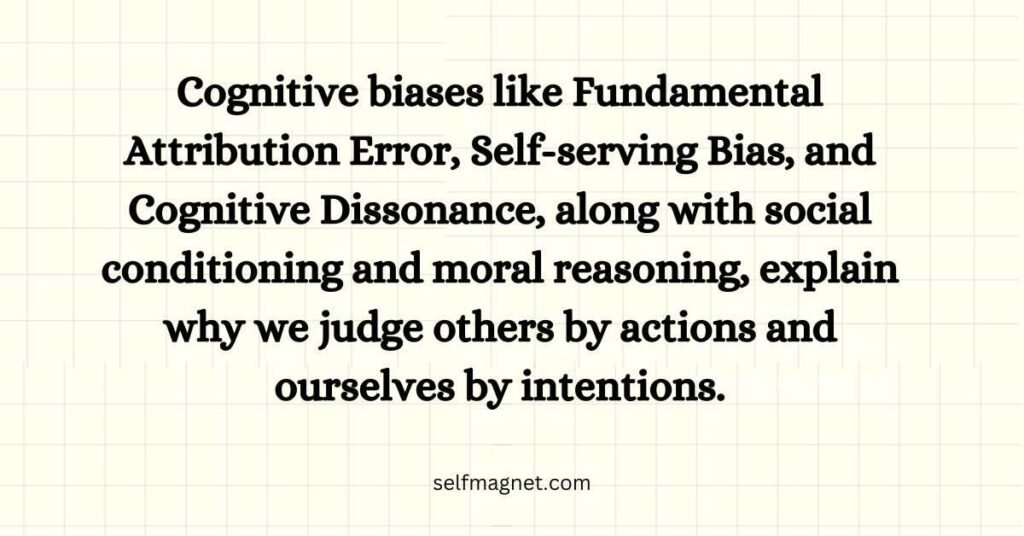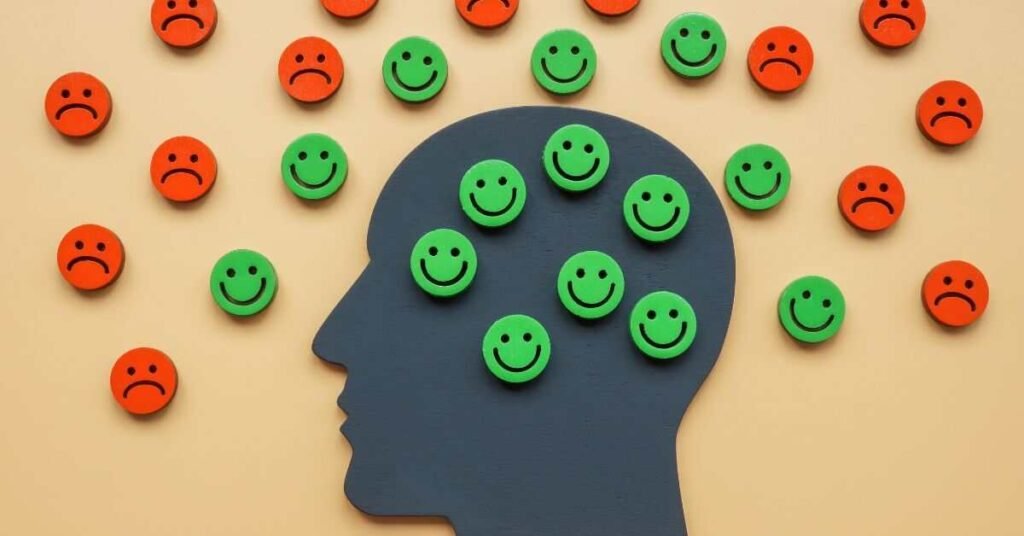In our everyday lives, we often find ourselves quick to judge others by their actions, while we tend to evaluate ourselves by our intentions.
This creates a perception gap that affects our relationships, decision-making, and overall well-being.
This insightful article delves deep into the psychological underpinnings of this bias and practical strategies to balance our judgments.
Great, I’m glad you’re happy with the introduction.
Let’s move on to the thought processes underlying these phenomena.
Why We Judge Others by Actions and Ourselves by Intentions: The Psychology Basis

This section delves into the core psychological concepts that explain why we judge others by their actions and ourselves by our intentions.
We’ll explore following the psychological reasons:
Fundamental Attribution Error
The Fundamental attribution error, known as the correspondence bias, is a major idea in social psychology.
This bias refers to attributing others’ behavior to their personality while ignoring situational factors.
We often assume people act a certain way because of who they are without thinking about the situation they’re in.
For example, if someone is late to a meeting, we might think they’re disorganized or careless rather than considering they could have been stuck in traffic.
This angle helps us realize how easily we make judgments without considering the context of others’ actions.
Self-serving Bias
The self-serving bias explains how we credit ourselves for positive events and blame external factors for negative outcomes.
This distortion affects how we view our intentions versus our actions.
Like, if someone on the team misses a deadline might be labelled as unreliable or incompetent.
But when we cannot meet a deadline, we think about the different tasks we have or the unexpected obstacles we face.
This bias causes a difference in how we evaluate ourselves and others.
It results in an excessively positive self-perception and possibly harsher judgments of others.
Cognitive Dissonance
Cognitive dissonance arises from conflicting beliefs, attitudes, or habits, causing discomfort.
We align our beliefs and actions to ease discomfort.
Cognitive dissonance makes us justify our actions that contradict our intentions.
Let’s say we see ourselves as environmentally conscious but have a habit of forgetting to bring reusable bags to the grocery store.
To feel better, we might focus on our good intentions rather than our actual behavior.
Cognitive dissonance clarifies self-forgiveness while judging others.
Social and Cultural Conditioning
Society teaches us to judge others by their actions.
Legal systems, for instance, prioritize actions over motives.
This conditioning reinforces behavior-based assessments.
Intentions as Moral Indicators
We often believe that our intentions reflect our true moral character.
Even if our actions have negative outcomes, we excuse them by saying we meant well.
People apologize, “I didn’t mean to hurt you,” hoping their intentions are valued over the outcome.
These principles reveal how cognitive processes affect our perceptions.
Identifying biases is the first step to a more balanced and emotional insight into ourselves and others.
Let’s discuss the next section.
How to Bridge the Gap

Now, let’s explore practical strategies to resolve the differences and develop awareness in our interactions.
Practicing Empathy
- Perspective-taking exercises: Regularly practice putting yourself in others’ shoes. When observing someone’s actions, pause and consider what circumstances or intentions might be driving their attitude.
- Active listening: Understand others when they speak, rather than just waiting for your turn to respond. This can reveal useful insights for their moves.
- Empathy mapping: Create mental or physical maps of others’ thoughts, feelings, and motivations to appreciate their efforts better.
Seeking Context Before Judging
- Ask questions: When someone’s actions confuse or upset you, ask for clarification instead of jumping to conclusions.
- Observe patterns: Look for habit patterns over time rather than analyzing isolated incidents. This can provide a more accurate picture of someone’s character and intentions.
- Consider situational factors: Remember to consider external factors that might be influencing someone’s choices.
Self-Reflection and Awareness
- Mindfulness practices: Regular mindfulness meditation can help you become more aware of your thoughts and judgments as they arise.
- Journaling: Keep a reflection journal to track your reactions to others’ efforts and your conduct. Observe trends in how you assess yourself versus others.
- Challenging your assumptions: When you find yourself making a quick judgment, pause and challenge that assumption. Ask yourself if you’d evaluate your own decisions the same way in a comparable event.
- Feedback seeking: Seek honest input from trusted friends or colleagues on your responses and how they view your purposes. This can help you mark blind spots in your self-perception.
- Cognitive restructuring: Practice reframing negative appraisal into more moderated, sensitive thoughts. For example, instead of thinking, “They’re so inconsiderate,” try ” “I wonder what could be driving their behavior.”
By implementing these strategies, we can help close the disparity between how we rate others and ourselves.
The process requires consistent effort and practice.
In the next section, we’ll explore the benefits of overcoming the tendency to form opinions.
Benefits of Overcoming the Bias
Let’s explore the key benefits:
Improved Relationships
Overcoming the bias can dramatically enhance our personal and professional relationships:
- Increased trust: When we appraise others evenly, considering both their deeds and decisions, we build stronger trust in our relationships.
- Better conflict resolution: Comprehending others’ motives makes it easier to resolve conflicts constructively.
- Deeper connections: We form more meaningful and authentic connections.
- Reduced misunderstandings: We’re less likely to misinterpret others’ initiatives, leading to fewer unnecessary conflicts.
Better Communication
Addressing this bias can significantly improve our communication skills:
- Active listening: As we become more aware of our tendencies, we’re likely to listen more attentively to others, improving overall communication.
- Clearer expression: We express our aspirations evidently to avoid misunderstandings.
- Open dialogue: Creating an environment where desires are considered alongside performances encourages more open and honest communication.
- Constructive feedback: Feedback guides more helpful critiques.
Increased Emotional Intelligence
- Self-awareness: The process of recognizing and addressing this bias increases our overall self-awareness.
- Social awareness: You become more attuned to social dynamics and others’ emotional states.
- Empathy development: Seeing through others’ eyes enhances our capacity for empathy.
- Emotional regulation: You can more effectively regulate how you feel about others’ actions.
- Adaptability: You become adjust to various social and professional situations.
Personal Growth
Overcoming the prejudice propel personal development:
- Increased self-reflection: The process encourages us to examine our thoughts, behaviors, and biases more closely.
- Reduced stress: Criticize others less harshly. We can reduce interpersonal stress and anxiety.
- Improved decision-making: Improved decisions can be achieved in both personal and business contexts.
- Greater resilience: You can bounce back from perceived slights or disappointments more easily.
The rewards of improved relationships, better communication, increased emotional intelligence, and personal growth make the effort well worthwhile.
Final Thoughts
The way we judge others by their actions and ourselves by our intentions allows us to develop empathy, practice more neutrality, and foster better communication.
By recognizing our cognitive biases and actively working to overcome them, we can create a more compassionate and understanding society.
Remember, everyone has a unique story behind their acts, just as we do for our own.
As we move forward, let’s strive to connect goals with execution, both in how we perceive others and how we evaluate ourselves.
This change in viewpoint can enhance the depth of relationships, reduce conflicts, and a more emotionally intelligent approach to life’s challenges.
Share this article with others who may benefit from realizing the interplay between visions and efforts. We can add value to a more caring and harmonious world.
I simply could not go away your web site prior to suggesting that I really enjoyed the standard info a person supply on your guests Is going to be back incessantly to investigate crosscheck new posts
Thank you for your kind words! I’m glad you enjoyed the content and appreciate your support.
Glad you enjoyed the article.
This is interesting. I agree with it, and I hope you follow-up by addressing the role cultural differences play in enabling bias and defeating any thoughts of bridging the gap. Cultural differences, or cultural perceptions, are one of the precursors to, or companions of, many of the forms of bias you stated. Once in existence, once another culture is demeaned, the door opens to behaving in accordance with the biases of which you wrote. At least, that’s how I see it.